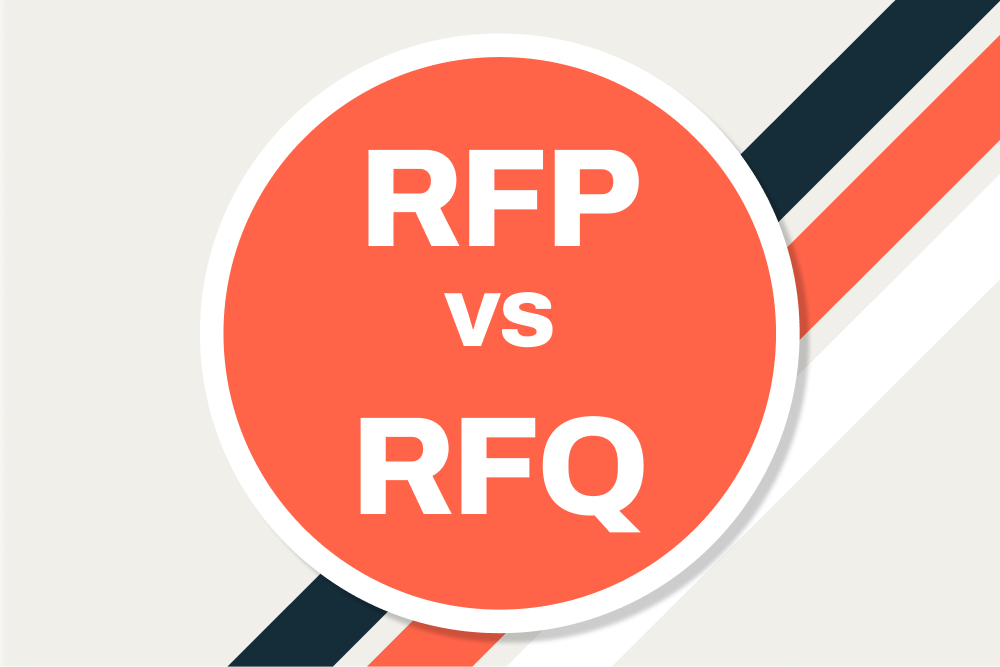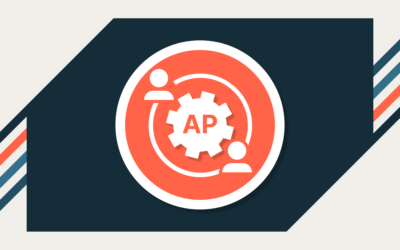When making a procurement decision, an organization wants to secure the most favorable terms possible with the best supplier possible. That means a lot of due diligence to ensure they’re making the best purchase for their business needs.
To be sure they have optimal terms, many organizations require vendors in the procurement process to submit either an RFQ (Request for Quote) or an RFP (Request for Proposal).
These two documents play a crucial role in helping organizations make informed decisions about which vendor to select — a vital part of an effective procurement strategy. In general, an RFP is used to support a more strategic type of purchase where the vendor or supplier will become a strategic partner to the buyer. An RFQ is appropriate for more transaction-based relationships where the buyer is making a one-time purchase or does not expect to have a strategic relationship with the vendor or supplier.
The nuanced difference between an RFQ and an RFP is explored below. You’ll discover when to use an RPF vs RFQ and understand the reasons why this is an important step for procurement teams.
What is an RFP?
An RFP, or Request for Proposal, is a formal document that organizations use in the formal process of gathering key information.
An RFP serves as a comprehensive outline of a purchasing project’s requirements, goals, and specifications, which helps businesses to invite competitive bids from multiple vendors.
Typically, a Request for Proposal also includes specific additional details about the project, such as:
- The scope of work.
- The desired outcomes.
- The proposed timeline.
- Any budget constraints.
- The evaluation criteria.
- Key milestones.
Goals of an RFP.
By issuing an RFP, organizations give prospective vendors an understanding of the intricacies and expectations of the project. They can then submit well-structured proposals that address the outlined needs.
An RFP is crucial for procurement and vendor management since it creates transparency and fair competition among potential suppliers.
It also enables businesses to assess and compare proposals based on pre-defined and consistent criteria for all responders. This helps to make informed, impartial decisions when selecting a vendor.
The formal RFP process encourages vendors to provide detailed information on their capabilities, approach, and pricing so organizations can identify the most qualified and cost-effective solution.
Overall, an RFP is a strategic document that plays a pivotal role in facilitating thorough and competitive procurement.

What is an RFQ?
An RFQ, or Request for Quote, is similar to an RPF in that it is a formal document used in the vendor selection process.
An RFQ is sent to prospective suppliers or vendors for the entire project, inviting them to submit price quotations for specific products or services.
A well-done RFQ outlines the detailed requirements of a project or purchase, with key topics such as:
- Quantity.
- Specifications.
- Delivery terms.
This information helps suppliers to provide precise quotes based on the best price for the specified parameters.
Goals of an RFQ.
The primary goal of an RFQ is to facilitate streamlined and efficient procurement, especially when the organization’s requirements are clear and the emphasis is on obtaining competitive pricing.
By issuing an RFQ, businesses can receive detailed quotes from multiple suppliers, allowing them to compare costs and offerings before making an informed decision.
The RFQ process is particularly beneficial in scenarios where pricing is emphasized and the project’s specifications are relatively clear. The decision-making process makes it a valuable tool in the overall procurement strategy of many organizations across various industries.

Guided Procurement Tour
Explore our automated procurement workflows in the Guided Procurement tour.
RFP vs RFQ: Key differences.
Here’s a detailed breakdown of the key differences between an RFQ and an RFP.
Purpose.
RFP (Request for Proposal): The primary purpose of an RFP is to solicit detailed proposals from potential suppliers or service providers for complex purchases.
An RFP aims to gather comprehensive and relevant information on how vendors would approach and fulfill the requirements and requested services as outlined by the organization. RFPs are useful when a business expects to enter into a long-term relationship with a supplier, especially where deliverables may be spread out over several quarters and the relationship is expected to be responsive to changes in scope and timing.
RFQ (Request for Quote): The primary purpose of an RFQ is to gather pricing information from vendors for specific goods or services. It is more focused on obtaining detailed quotes that include pricing, payment terms, and conditions rather than detailed project proposals. It’s an effective way to solicit quotes from several suppliers for a single transaction, and an ongoing relationship with the supplier will not be necessary to fulfill exact requirements.
Information required.
RFP: An RFP typically requires specific and wide-ranging information, including the vendor’s qualifications, proposed methodology, and project timeline. Many RFPs also request a sample of past work or a reference to contact.
Simply put, an RFP seeks to understand not only the various cost savings but also the approach and capabilities of the vendors.
RFQ: An RFQ primarily focuses on obtaining specific information related to pricing, payment terms, delivery schedules, and other contractual details.
It is less concerned with the vendor’s approach to complex processes or methodology than an RFP.
Complexity.
RFP: Generally used for more complex purchases or services where the organization needs a comprehensive understanding of the vendor’s capabilities and proposed solution.
RFQ: Suited for relatively straightforward procurement needs, the primary evaluation factor is obtaining competitive pricing for a specific project.
Criteria for evaluation.
RFP: Criteria for RFPs often include factors in addition to costs, such as:
- Technical expertise.
- Experience.
- Project methodology.
- Overall ROI.
RFQ: In contrast, the main evaluation criteria for RFQs typically revolve around pricing, preferred payment terms, and compliance with specified requirements.
Scope of Work.
RFP: Typically used for projects and companies with a broader and more detailed scope of work. The RFP may include detailed project objectives, specifications, deliverables, and performance expectations.
RFQ: Well-suited for the procurement team’s needs with a clearly defined and relatively straightforward scope of work, focusing more on product specifications and pricing options.
Vendor responses.
RFP: Vendors responding to an RFP are expected to provide detailed proposals that address the project’s intricacies, outlining their approach, qualifications, and capabilities. They may be asked to provide examples of past work or references to similar projects.
RFQ: Vendor responses to an RFQ are more straightforward, typically containing detailed pricing information, delivery schedules, and other specific contractual details.
Use cases.
RFP: Commonly used in industries such as technology, consulting, and construction where procurement involves complex projects or services requiring a thorough understanding of the project and vendor’s capabilities.
RFQ: Frequently used for products where the primary consideration is obtaining competitive pricing for standardized goods or services and product differentiation is not a factor.

What is an RFI and when should you use it?
A third type of document in the initial procurement process is an RFI, or Request for Information. An RFI can even help determine if you should use an RFP or an RFQ in the next stages.
Goals of an RFI.
An RFI is used in the early stages of procurement to gather information from suppliers or vendors.
An RFI is less formal than an RFP or RFQ and requests more general information instead of asking for specific project proposals or price quotes.
Scenarios for an RFI.
Here are some use cases which could call for an RFI.
Market intelligence.
If you are exploring a new market or industry and want to gather data to understand the capabilities of suppliers, an RFI can help you gather information.
Vendor qualification.
Before initiating a more formal evaluation process, an RFI helps assess the qualifications of potential vendors.
You can ask for information on a prospective vendor based on their experience, financial stability, technical expertise, and other relevant details.
Technology assessment.
In the context of technology projects, an RFI can be used to gather information about available technologies, software solutions, or service providers.
This helps understand the market offerings before diving into a detailed selection process.
Solution exploration.
When you have a project manager with a general problem to solve but are unsure about or not up to date on the specific solutions available, an RFI can help explore what solutions are out there and gather information about how vendors would approach the challenge.
Pre-qualification.
If you are planning a large-scale project and want to pre-qualify suppliers before issuing a more detailed RFP or RFQ, an RFI allows you to narrow down the list of qualified candidates.
A big advantage of an RFI is the flexibility to gather information without committing to a more formal buying process. It can help you make informed decisions on how to proceed to a more detailed solicitation, such as an RFP or RFQ.
Using an RFI provides the procurement team with the flexibility to gather valuable insights and information without committing to a formal procurement process.
It serves as a preliminary step to identify potential vendors, assess their capabilities, and make informed decisions about whether to proceed with a more detailed solicitation, such as an RFP or RFQ. This helps reduce procurement risk and wasted time on RFPs and RFQs that aren’t suitable.
Navigating procurement success through RFPs and RFQs.
Understanding the difference between RFPs (Request for Proposals) and RFQs (Request for Quotes) is pivotal for organizations navigating the complex landscape of modern procurement.
RFPs serve as comprehensive instruments designed for intricate projects, seeking detailed proposals that encompass not only cost control considerations but also vendors’ methodologies, qualifications, and overall value propositions.
An RFP is ideal when the scope of work is extensive, and the organization requires a thorough understanding of the vendor’s capabilities to make an informed decision. Many stakeholders are typically involved.
On the other hand, RFQs are tailored for more straightforward procurement needs, emphasizing competitive pricing for specific goods or services.
An RFQ focuses primarily on obtaining detailed quotes, including pricing structures, payment terms, and other contractual specifics. RFQs are efficient tools for scenarios where the scope of work is well defined, and the primary objective is to secure cost-effective solutions.
Ultimately, the choice between an RFP and an RFQ hinges on the nature and complexity of the project, as well as the organization’s priorities and requirements.
Toward more modern procurement.
Vendor management begins with a good RFP and RFQ process. This process sets expectations for the relationship that both parties agree to up front. An RFP or RFQ defines the terms of the relationship so that everyone understands the levels of service or the specifications of products that the buyer is willing to pay for.
It will then be up to the vendor or supplier whether they wish to simply meet those requirements or work to exceed them.
By strategically employing these procurement instruments, businesses can optimize their decision-making processes, fostering transparency, fair competition, and the selection of vendors aligned with their unique project needs and strategic objectives.



Schedule a demo
Learn how Airbase can transform your entire purchasing process.
 Jira Integration – Streamline Your Workflows
Jira Integration – Streamline Your Workflows  Ironclad Integration – Simplify Legal Operations
Ironclad Integration – Simplify Legal Operations  Asana
Asana 




